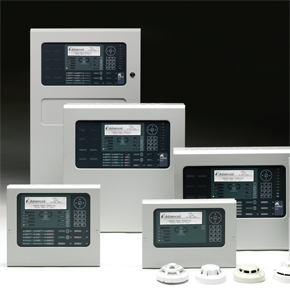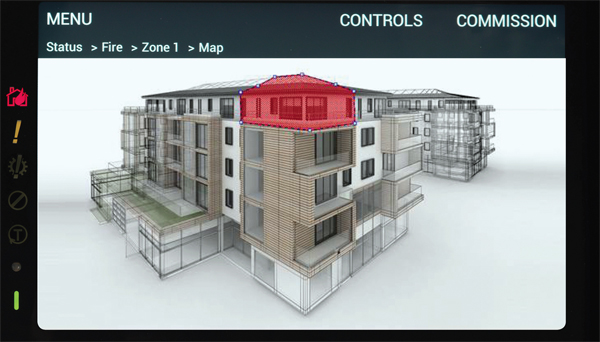
The growing importance of false alarm management
False fire alarms are a huge issue in fire safety management today. They are costly in financial terms and can seriously impact the efficacy of any building’s fire planning. Advanced Electronics discusses the solutions on offer that have been designed to reduce such false alarms…
The latest developments in fire system technology offer a number of solutions to minimise false alarms. The key is to verify whether there is a real fire before the next stage of the building evacuation strategy commences.
False alarm reduction should be considered as part of the risk assessment, before any specification is written. Each building will have different users and specific circumstances that may require unique verification, investigation and evacuation processes. All of this can occur under one roof and over multiple floors, so flexibility is key.
The industry has taken two main approaches. One is focused on detector head technology that looks at reducing incorrect signals in the heads themselves, the other is an approach that focuses on signal processing and decision making in the fire control panel. Some forward-thinking manufacturers are combining the two into approaches to combat the causes of false alarms from multiple directions.
The development of intelligent detectors, the most sophisticated of which use smart algorithms to differentiate between real fires and false signals, perhaps caused by steam or cooking smoke, has accelerated in recent years.
Detectors can also be used together or in other modes to reduce false alarms. For example, multi-sensor detectors can be switched between heat and smoke in order to confirm a signal. Several detectors can also be combined, for example using double knock or coincidence to confirm a genuine signal.
Automatic, addressable fire systems will analyse detector signals and then, if the signals match expected criteria, will activate a range of verification and confirmation procedures. A good fire system can do a huge amount automatically and much can be achieved with minimal human intervention. However, one of the key ways to reduce false alarms is to involve people and, in order to make this effective, some manufacturers have introduced dedicated false alarm input devices.
Some manufacturers are introducing trained residents into the verification equation with buttons, either intelligent loop devices or simplified repeater inputs, that allow the verification time on a system to be extended by the occupant if they believe the signal to be false in their area, for example from burning toast. If the signal clears, the system returns to normal but, if it persists beyond a pre-set verification time, the system will go into full alarm.
Involving people, even trained individuals, means failsafes must be strong. Different manufacturers have adapted varying solutions but, in general, buttons of this type should only be pressed once before a system reset, and times need to be programmable. If an alarm signal has been verified by the panel, or if a manual call point is activated, the system should enter a full fire alarm condition immediately. Equally, if a preset number of areas are in verification (ie. detecting potential fire signals) the system should go into full alarm. The benefits of involving the residents of an apartment or student accommodation building are, however, hard to ignore.
Another key aspect to consider when specifying a false alarm management system is the ease of management. Can the system be divided precisely into different areas? Can points be managed singly or grouped, as in an apartment and is it easy to programme and install? On big sites wiring and configuration can add much complexity and cost.
Equally, priority should be given to selecting a system that is acceptably intuitive for staff and designated users to operate. The ability to share information in dynamic fire conditions has also developed rapidly, for example some touchscreen displays are a key tool that can make it easier to identify the location and status of an alarm.
Careful consideration should also be given to how the system will be monitored, serviced and maintained. There are a growing number of solutions that allow fire systems to be remotely monitored and controlled over the internet, which means an engineer can arrive with an agreed plan and all spare parts required, minimising disruption to the building’s users.
In summary, false alarms remain a problem but the industry has the tools to radically reduce them and their impact. This will certainly involve trained professionals at the design and specification stage and possibly the trained residents of a building.
Find out more in the August issue of Public Sector Building Magazine.
Latest news

19th April 2024
ASSA ABLOY: Access solutions can impact sustainability performance across the full life-cycle of a building
Embedding sustainability within any organisation requires a broad, strategic perspective. Scrutiny should include the physical infrastructure itself: According to the IEA, buildings consume around 30% of global energy*. ASSA ABLOY has more…
Posted in Access Control & Door Entry Systems, Architectural Ironmongery, Articles, Building Industry News, Building Products & Structures, Building Regulations & Accreditations, Building Services, Case Studies, Doors, Facility Management & Building Services, Information Technology, Research & Materials Testing, Retrofit & Renovation, Security and Fire Protection, Sustainability & Energy Efficiency, Video of the Week
19th April 2024
British weather doesn't dampen spirit for new HMG Garden Paint
Despite one of the wettest starts to the year on record, customers are starting to plan for brighter days with HydroPro Garden Paint from HMG Paints.
Posted in Articles, Building Industry News, Building Products & Structures, Garden, Innovations & New Products, Paints, Paints, Coatings & Finishes, Restoration & Refurbishment, Retrofit & Renovation, Site Preparation, Sustainability & Energy Efficiency, Waste Management & Recycling
18th April 2024
Abloy UK showcases new digital portfolio at The Security Event 2024
Abloy UK is set to unveil its latest line-up of access control systems at The Security Event 2024, welcoming guests to explore its cutting-edge electromechanical and digital solutions on stand 5/F50.
Posted in Access Control & Door Entry Systems, Architectural Ironmongery, Articles, Building Industry Events, Building Industry News, Building Products & Structures, Building Services, Doors, Exhibitions and Conferences, Facility Management & Building Services, Health & Safety, Information Technology, Retrofit & Renovation, Security and Fire Protection
18th April 2024
Strand is a Failsafe Choice for Emergency Exit and Panic Hardware
In times of emergency, you’re in safe hands with Strand Hardware. Although there are many considerations for building specification, few decisions can be as critical as selecting the right emergency exit/panic hardware.
Posted in Access Control & Door Entry Systems, Architectural Ironmongery, Articles, Building Industry News, Building Products & Structures, Building Services, Doors, Facility Management & Building Services, Health & Safety, Restoration & Refurbishment, Retrofit & Renovation, Security and Fire Protection
 Sign up:
Sign up: 